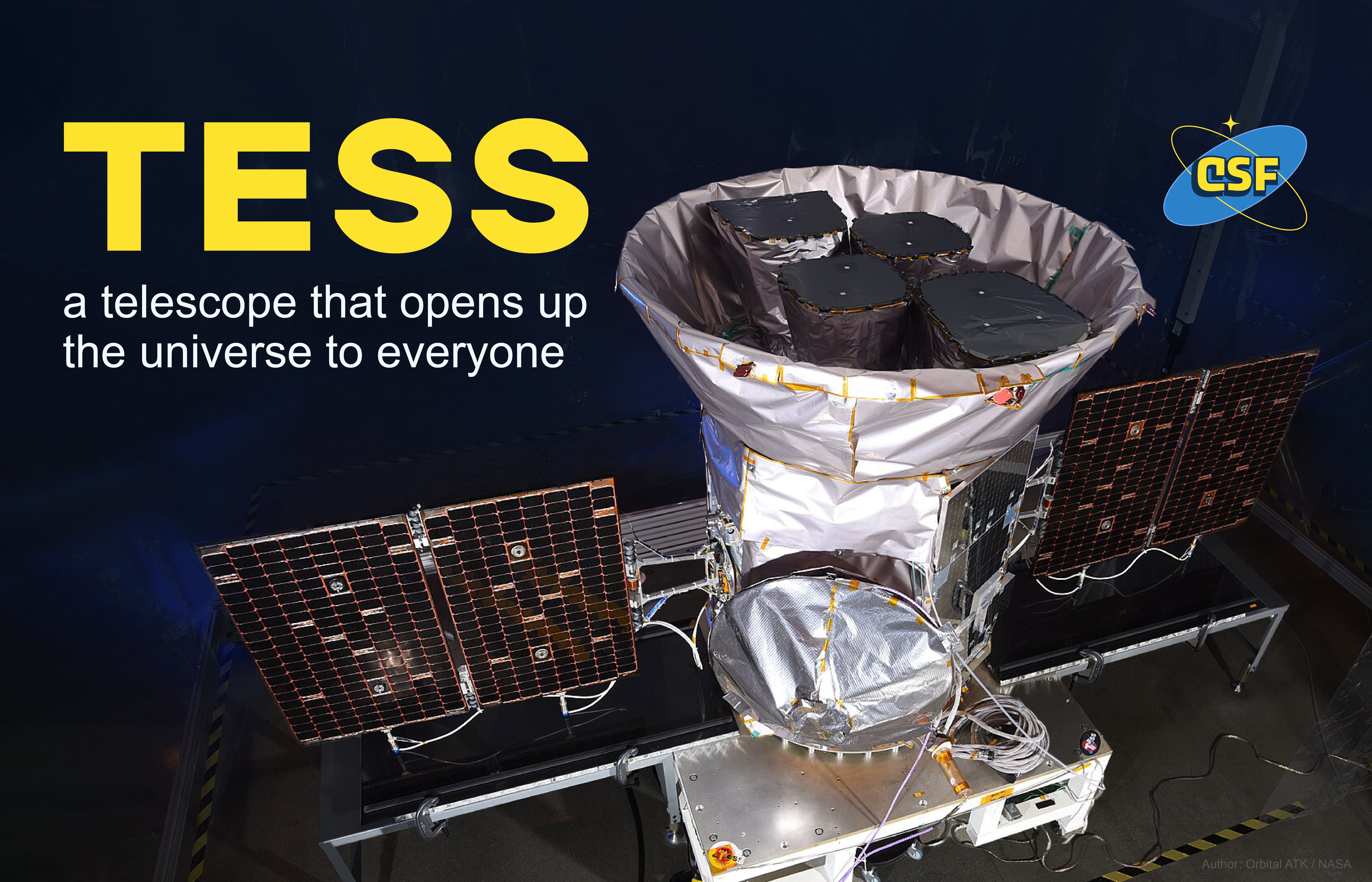 616
616
TESS: a telescope that opens up the universe to everyone

Long gone are the days when astronomical research required membership in scientific institutions or winning international grants. Now, everyone has an equal opportunity to explore distant worlds: both experienced scientists and amateur astronomers. And all thanks to TESS — a space telescope with an open database of collected data.
Read more about TESS, the discoveries made with its help, plans, and the work of Ukrainian astronomers using its data in our article.
What is TESS?
The Transiting Exoplanet Survey Satellite (TESS) is a space telescope designed to search for exoplanets (i.e., planets outside our solar system) using the transit method. TESS is a NASA Explorer-class mission led by the Massachusetts Institute of Technology (MIT).
Launched on 18 April 2018, the TESS space telescope operates in a highly elliptical orbit, ensuring long-term continuous observation of stars. This allows for ultra-precise light curves with a resolution of up to thousandths of a star's magnitude — much more accurate than low-orbit telescopes.
TESS telescope before launch
Source: TESS Telescope Information
The telescope captured its “first light” (i.e., its first image) on 7 August 2018, and it was published on 17 September of the same year. This image was created by combining frames from all four of its cameras.
First image from TESS
Source: First Light! TESS Shares First Science Image in Hunt to Find New Worlds
The telescope covers 85% of the sky within approximately 200 light-years (for comparison, the previous Kepler telescope mission covered only 0.25% — 340 times less!). The telescope takes full-frame images with an exposure time of about 30 minutes, allowing scientists to detect unexpected transient phenomena such as gamma-ray bursts.
Scientific data is transmitted from TESS to Earth approximately every two weeks.
Purpose of TESS
The main purpose of the TESS telescope is to search for exoplanets. It observes a large area of the sky and records exoplanet candidates. If their existence is confirmed, other telescopes are used to explore and study the chemical composition and characteristics of the exoplanets.
In fact, TESS can be considered a provider of search “targets” for the James Webb Space Telescope (JWST) and other major space programs for the search and study of exoplanets, scheduled to be launched in the future.
Transit method
TESS searches for exoplanets using the transit method of observation. The method is based on the fact that when a planet passes across the disk of its parent star (this is called a transit), a decrease in the brightness of the star becomes noticeable.
Illustration of how the transit method works
An example of transit in our solar system is the transit of Venus across the Sun in 2004.
Venus transit across the Sun in 2004.
Source: 2004 Venus Transit Photo Gallery
Although confirming the existence of a planet requires a lot of time and further observations with ground-based telescopes, the method is effective for large planets with short orbital periods – the so-called “hot Jupiters.”
TESS discoveries
As of May 2025, according to NASA Exoplanet Archive data, the TESS telescope has discovered 636 confirmed exoplanets and 7,655 exoplanet candidates (TESS Objects of Interest, TOI) that are still awaiting confirmation or rejection by the scientific community.
Among the most important discoveries of the TESS telescope are:
- TOI 700 d, a planet similar in size to Earth, orbiting a red dwarf in a zone potentially suitable for liquid water;
- TOI-1231, a Neptune-sized planet located in the habitable zone around a red dwarf;
- several “hot Jupiter” exoplanets with orbital periods of less than two days;
- several “super-Earths” with masses about five times greater than Earth's;
- confirmation that the star Alpha Draconis is an eclipsing binary system.
In addition to these discoveries, hundreds of other large and small findings have been made, which can be accessed from open scientific sources, including the official TESS website.
TESS missions
The first TESS mission lasted two years and showed extremely successful results. Since the orbit remains stable, the equipment is working well, and the number of discoveries has exceeded expectations, NASA has approved the extension of the mission.
The current list of TESS missions is as follows:
- First primary mission (2018–2020): search for exoplanets around bright stars in 26 observation sectors.
- First extended mission (July 2020–2022): re-observation of the same sectors to discover new exoplanets and refine details about the known ones.
- Second extended mission (2022–present): expanding observations to new areas of the sky.
According to forecasts, TESS's orbit will remain stable for at least another 10 years after launch (i.e., until approximately 2028), and the telescope currently has sufficient resources to continue operating.
How to contribute to research
The TESS mission not only discovers new exoplanets, but also provides public access to a large amount of astronomical data that anyone can work with, from amateurs to professional astronomers. Just imagine: anyone can access unique and up-to-date data captured by a powerful space telescope!
TESS data opens up a wide range of opportunities for scientific research:
- analysing star light curves to search for new exoplanet transits;
- studying variable stars or stellar activity;
- comparative analysis with data from other missions (e.g., Gaia, Kepler, or ground-based telescopes);
- creating your own automated transit search algorithms.
The official data archive for the mission is the Mikulski Archive for Space Telescopes (MAST).
MAST has created a special page with instructions and tools for working with TESS data. Below are the main features for those who want to contribute to the research:
- MAST Portal is the main interface for accessing the TESS archive. Here you can:
- download light curves, pixel data of objects, and full-frame images;
- receive reports with the results of exoplanet candidate validation;
- search for objects using the TESS Input Catalog (TIC) or Candidate Target List (CTL);
- filter data by coordinates, magnitude, rotation period, etc.
- TESS Input Catalog (TIC) – a catalog with data on over 1.7 billion point sources and over 100 million extended sources. It's used to identify targets and figure out the physical characteristics of stars, like temperature, radius, mass, and so on.
- Candidate Target List (CTL) – a subset of TIC with about 9.5 million stars that are considered the most promising for detecting exoplanets using the transit method. CTL helps select stars around which new planets are most likely to be found.
In addition, there is a large number of open source tools and libraries for analysing TESS data, including:
- Lightkurve (for working with light curves);
- eleanor (for obtaining light curves from full-frame images);
- EXOTIC (for analysing exoplanet transits).
Detailed information about TESS products can be found here.
What's next: the future of TESS
This powerful telescope continues to discover a multitude of diverse worlds located near the Sun — some similar to our planet, others completely different.
In the future, instruments such as the James Webb Space Telescope, the Nancy Grace Roman Space Telescope, and the European Space Agency's ARIEL telescope will explore the list of nearby worlds discovered by the TESS telescope in more detail, studying their atmospheres and chemical composition to better understand how exoplanets form and evolve.
Who knows — maybe one day one of these telescopes will discover a habitable exoplanet similar to our Earth. And it is quite possible that the basis for this discovery will be the data collected by the TESS telescope!
Ukraine and TESS
Ukrainian researchers have access to data from the TESS space telescope and can use it for their own scientific discoveries. However, due to the small number of both professional astronomers and enthusiastic amateurs, there are still very few publications featuring Ukrainian participation.
According to the NASA TESS Mission Science Support Center, there are currently 32 publications by Ukrainian authors — 30 articles and 2 abstracts. For comparison, as of June 2025, 2,755 scientific papers based on TESS data have been published worldwide.
But we at the Clear Skies Foundation are actively working to improve the situation! Our mission is to develop astronomical education and science in Ukraine. We teach beginners — both those who have already taken their first steps in astronomy and those who are just thinking about it.
Our projects, TESS-UA and Star Hunters, aim to teach young people how to work with TESS telescope data to study exoplanets, variable stars, and potentially habitable planets. The team includes professional astronomers, beginners, and enthusiasts from other fields.
We will tell you more about the project and its findings in one of our upcoming articles, so stay tuned for updates so you don't miss a thing!
CSF Contacts
If you have any questions about using TESS telescope data or are interested in joining our scientific projects, please send an email to contact@csf-ua.com — we are always happy to help!
Let's move on to discoveries!



